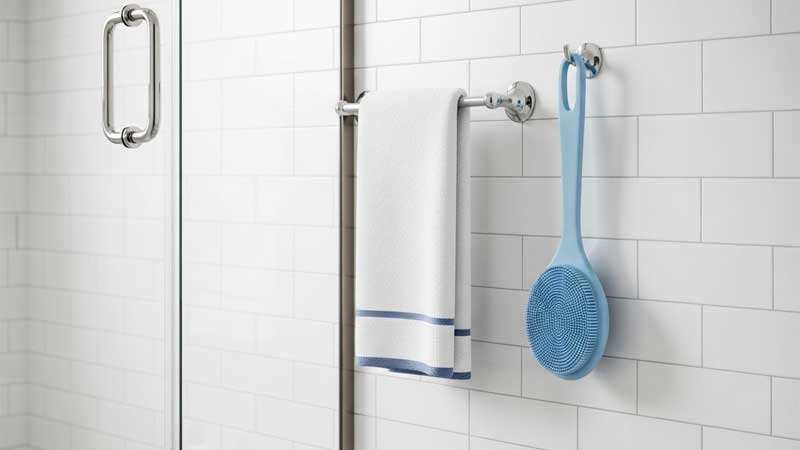Silicone body scrubbers are gaining popularity thanks to their softness, comfort, durability, and hygienic properties. Many people assume that simply rinsing the scrubber is enough. In reality, deep cleaning and regular maintenance are essential to keep your silicone body scrubber hygienic and extend its lifespan.
This guide will take you step by step through proper cleaning and care, ensuring every shower is safe and enjoyable.

Why Is Cleaning a Silicone Body Scrubber Important?
Many people believe silicone stays clean because it doesn’t absorb water and resists bacteria. But even with its smooth, dense surface, dirt and germs can still stick to it.
When you shower, the soft bristles reach into your pores to remove oil, dead skin, and dirt. Some of this can get stuck deep at the base of the bristles. A quick rinse may wash away the foam, but not all the residue. Over time, this buildup can form a dirt crust that becomes a breeding ground for bacteria and mold.
If you don’t clean it well, silicone body scrubber can lose its cleaning power, start to smell, and even irritate your skin. Regular cleaning keeps your silicone body scrubber fresh, safe, and long-lasting.
How to Clean Your Silicone Body Scrubber Daily?
Silicone resists water and bacteria, but its bristles can still trap dead skin, soap, and tiny bits of dirt. Daily cleaning is the first step to keeping your silicone body scrubber clean and safe. It’s like brushing your teeth, something you should do every day.
| Step | How to Do It | Why It Works |
| 1. Rinse with Warm Water | Use water at about 45°C. Rinse the bristles from different angles for 30 seconds while gently rubbing the base with your fingers. | The water pressure and warmth remove over 90% of visible residue. |
| 2. Gentle Scrub | Add a small amount of mild detergent. Use your fingers or a soft toothbrush to clean between the bristles. | Clears away fine particles and oils you can’t see, keeping the bristles soft and fluffy. |
| 3. Thorough Rinse | Rinse with clean water until no soap remains. | Prevents chemical residue, making it safe even for sensitive skin. |
| 4. Drain and Air-Dry | Shake off excess water, then hang in a well-ventilated place. Avoid direct sunlight or closed, damp spaces. | Drying is the best way to stop bacteria, mold, and odor. |

How to Deep Clean Your Silicone Body Scrubber?
Even with daily cleaning, dirt, oil, and microorganisms can remain deep in the bristles. To keep your silicone body scrubber hygienic and extend its lifespan, a deep cleaning every 1–2 weeks is recommended. Regular deep cleaning reduces microbial buildup inside the bristles and keeps them soft and comfortable, making every shower cleaner and safer. Here are some effective, safe, and easy methods.
| Cleaning Method | Suitable For | Notes |
| Warm Soapy Water Soak | Regular deep cleaning | Soak in warm water with a small amount of mild detergent for 10–15 minutes. Gently rub the bristles with your fingers. |
| Boiling Water | 100% food-grade or medical silicone | Only for heat-resistant scrubbers; not suitable for brushes with plastic or metal parts. Boil for 3–5 minutes. |
| Vinegar Soak | Remove soap scum, limescale, and odors | Mix white vinegar and water 1:1. Soak for 20 minutes, then rinse thoroughly with water. |
| Baking Soda Paste | Surface dirt and odor removal | Mix baking soda with a little water into a paste, apply, let sit a few minutes, then gently scrub the bristles. |
| Disinfectant Soak | Special needs, medical or heavy disinfection | Dilute according to instructions. After soaking, rinse thoroughly with plenty of water. |
After cleaning, make sure to dry the scrubber completely. Avoid storing it in a damp environment to prevent bacteria from growing again.

What Are Common Mistakes When Cleaning a Silicone Body Scrubber?
Many users make mistakes that seem harmless but can hurt hygiene and shorten the life of their silicone body scrubber. Knowing these common errors helps you protect your scrubber and keep it clean.
Assuming silicone stays clean and skipping washing
Even though silicone resists water, dead skin, oils, and shower gel can stick at the bristle base. Skipping cleaning lets bacteria build up, reduces effectiveness, causes odor, and may irritate skin.
Using steel wool or hard brushes
Scrubbing with steel wool or stiff tools can scratch the silicone, damage bristles, and weaken its antibacterial and water-repellent properties, shortening its lifespan.
Leaving the scrubber in a damp bathroom corner
High humidity lets water sit at the bristle base, promoting mold and bacterial growth. Even with silicone’s resistance, long-term dampness can cause odor and black spots.

Frequent soaking in strong bleach
Bleach kills bacteria, but high concentrations or frequent use ages silicone. Bristles may harden, become brittle, or crack. Residual bleach can irritate skin.
Neglecting bristle roots and gaps
Rinsing only the surface leaves dirt in hidden areas like the bristle base or handle crevices. These spots collect soap and skin flakes, allowing bacteria to grow and cause odor or stickiness.
Scrubbing too hard or repeatedly
Using too much force can bend or break bristles and damage the smooth silicone surface. Damaged bristles reduce cleaning power and trap bacteria.
Ignoring drying and ventilation
Putting the scrubber back wet or in a closed space keeps it damp. Long-term moisture shortens bristle life and encourages mold and odor.

Conclusion
A clean silicone body scrubber not only enhances your shower experience but also helps protect your skin health. Daily rinsing, regular deep cleaning, and proper storage are the keys to keeping your scrubber clean, durable, and safe to use. Developing a good cleaning habit ensures your shower time always feels fresh and worry-free.
If you want high-quality silicone products, come to our company. With extensive experience and advanced technology, we can help you customize silicone solutions that meet your needs.